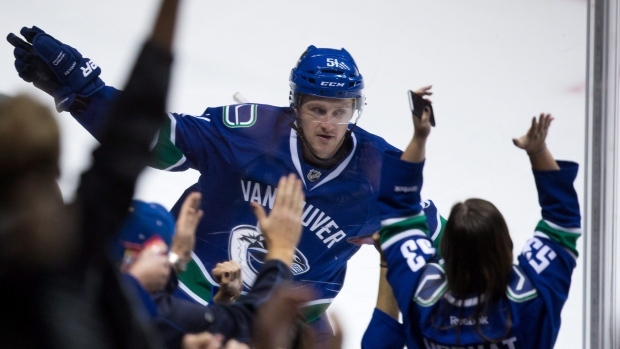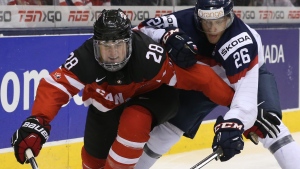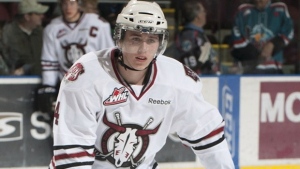Nov 11, 2015
Position battles in full swing for Canadian World Junior squad
TSN Hockey Insider Bob McKenzie takes a look at the national junior team landscape and the battle for positions six weeks before Canada opens defence of its title in Finland.
By Bob McKenzie

Canada opens defence of its World Junior Championship six weeks from this Saturday in Finland, but the battle for positions is already in full swing.
Hockey Canada will, of course, have one eye on the NHL to see what, if any, underage juniors will be loaned to Team Canada for the Dec. 26 - Jan. 5 tourney in Helsinki. The primary focus now, however, is on the Canadian Hockey League Super Series – six games against a touring Russian team that gives potential Canadian national junior team members a last chance to impress enough to be named to Hockey Canada’s final selection camp, Dec. 10-14 in Toronto.
The Western Hockey League Super Series teams scored a pair of wins over the Russians – 7-3 in Kelowna on Monday and 4-2 in Kamloops on Tuesday.
The Ontario Hockey League Super Series teams play in Owen Sound on Thursday and Windsor on Monday; The Quebec Major Junior Hockey League teams play Tuesday in Rouyn-Noranda and next Thursday in Halifax.
It’s an intensive stretch for everyone involved – from national junior team manager Tim Speltz to director of player personnel Ryan Jankowski to this year’s Team Canada coaching staff that includes head coach Dave Lowry and assistants Dominique Ducharme, Kelly McCrimmon and Trevor Letowski, as well as the players, many of whom will be facing the busiest and most pressure-packed stretch of games in their young careers.
Using the roster from Hockey Canada’s summer evaluation camp, as well as the respective WHL/OHL/QMJHL Super Series rosters, and, of course, the junior-aged talent still in the NHL, let’s take a look at the national junior team landscape and battle for positions, as it currently exists:
POTENTIAL NHL HELP
There are six junior-aged Canadians currently playing in the NHL – five forwards and one defenceman – but Hockey Canada knows it has no shot at three of them and no sure things on the remaining three.
Even if Edmonton’s Connor McDavid wasn’t injured with a broken clavicle, the Oiler phenom had already outgrown the WJC. Been there, dominated that.
Ditto for Florida Panther defenceman Aaron Ekblad, who was WJC-eligible last year but was too busy winning the Calder Trophy at the NHL’s top rookie.
There’s also no reason to believe the Calgary Flames would be willing to part with Sam Bennett, who this season has become a full-time player for them.
In fact, if the world junior tourney were being held today, Team Canada wouldn’t necessarily expect to get Rob Fabbri from St. Louis or Jake Virtanen and/or Jared McCann from Vancouver. All three are currently playing significant roles on their NHL teams.
But a lot can change in the next month. History suggests an NHL team’s injury situation, as well as how many minutes and how well the underage juniors are playing, are critical factors than can only truly be weighed and measured at the last possible moment a decision has to be made (mid-December). Since St. Louis general manager Doug Armstrong is also GM of Hockey Canada’s World Cup entry and has a long history with HC, the lines of communication are at least wide open on the Fabbri front.
For Team Canada’s purposes, getting any of Fabbri, Virtanen or McCann would be huge. Fabbri and Virtanen played on last year’s gold-medal team. Team Canada could use Fabbri’s elite skill as a top-line centre and right winger Virtanen would bring much needed size and physical play on a team that may not be deep in either area up front. McCann’s tremendous shot and skill level would also be welcome additions.
It is, however, strictly a wait-and-see proposition with no guarantees.
CENTRE
Assuming neither Fabbri nor McCann are made available, Moose Jaw Warrior and national junior team returnee Brayden Point can be penciled in as a potential No. 1 centre. The Tampa Bay third round-pick is smallish and not blessed with tremendous speed but he has an incredible knack to be the best player on the ice in almost any game he plays. His vision and skill are elite even if his size and speed are not.
Beyond Point, there is a trio of 18-year-olds, all chosen in last June’s draft, who could provide high-end skill. They include Arizona prospect Dylan Strome (third overall) of the Erie Otters, Toronto prospect Mitch Marner (fourth overall) of the London Knights and New York Islander prospect Mathew Barzal (16th overall) of the Seattle Thunderbirds. Marner has played a lot of right wing in junior and, historically, that is where Hockey Canada has played him, often times alongside Strome in the middle. So Marner is more likely a right winger, but there’s some flexibility there, depending on what happens with Fabbri and McCann.
Others who could also compete for spots in the middle include 19-year-old Colorado first-rounder Conner Bleackley of the Red Deer Rebels; 19-year-old New Jersey first-rounder John Quenneville of the Brandon Wheat Kings (who is playing left wing in Brandon this season but was a centre last season); 18-year-old Tampa prospect Mitchell Stephens of the Saginaw Spirit, who can play centre or right wing but is currently injured; as well as 2016 draft eligible Nolan Patrick of the Brandon Wheat Kings, a late 1998 birthdate. Islander first rounder Anthony Beauvillier of Shawinigan can play some centre, too, but the 18-year-old has lined up internationally on left wing, alongside Barzal at times.
The key, obviously, is whether Fabbri or McCann will be there. With or without them, though, it’s not a physically imposing group though the skill level is not in question.
RIGHT WING
Team Canada could really use Virtanen. It’s not a big or overly physical group on the right side.
One would have to think Marner is likely to be on the team and could be a key right winger if he doesn’t play centre. He’s 5-foot-11, 160 pounds.
A trio of 19-year-olds – Los Angeles King prospect Spencer Watson of the Kingston Frontenacs (5-foot-9, 170 pounds); Florida second-rounder Jayce Hawryluk of the Brandon Wheat Kings (5-foot-10, 197 pounds); and, Philadelphia second-rounder Nicolas Aube-Kubel (5-foot-11, 196 pounds) of the Val d’Or Foreurs will compete for spots on the right side.
So will a trio of talented 18-year-olds, including Philadelphia first-rounder Travis Konecny of the Ottawa ‘67s (5-foot-10, 176 pounds); Tampa prospect Stephens (5-foot-11, 188 pounds) and late 1997 birthdate Julien Gauthier, a 6-foot-4, 212-pound, scoring winger (18 goals in 21 games this season for Val d’Or) who is expected to be a high first-round pick this season. Pierre-Luc Dubois, a 6-foot-3, 202-pound 17 year old who is also a likely first round pick in this year’s draft, will also get a look even though he wasn’t at the summer camp.
What’s evident is that the biggest players on the right side are the younger and/or more inexperienced candidates. That’s why Virtanen becomes such a key piece of the Team Canada puzzle.
LEFT WING
On paper, Team Canada’s left side will be bigger potentially bigger than on the right side.
Start with sure-thing returnee Lawson Crouse, Florida’s 11th overall pick who plays for the Kingston Frontenacs. He’s a 6-foot-4, 211-pound bruiser who can skate and play top-line minutes.
Four 19-year-olds – Islander first rounder Michael Dal Colle (6-foot-2, 190 pounds) of the Oshawa Generals; Arizona first-rounder Brendan Perlini (6-foot-3, 205 pounds) of the Niagara Ice Dogs; San Jose prospect Rourke Chartier (5-foot-11, 190 pounds) of the Kelowna Rockets (just coming off a broken wrist); and, Boston first-rounder Jake DeBrusk (6 feet, 178 pounds), who is currently sidelined by an injury – are prominent candidates.

After a really slow start Dal Colle has scored four goals in his last three games, which should ease some of the prior concerns about an ice-cold sniper. Beauvillier, the 5-foot-10, 170-pound, 18-year-old Isles’ prospect from Shawningan, is another left-side possibility.
One player who hasn’t been mentioned yet in any of the three positions is Nick Merkley, the 18-year-old Arizona first-rounder in 2014 who plays for the Kelowna Rockets. That’s because he’s viewed as being able to play any of the three forward positions, so flexibility is certainly a strength for him.
Overall, up front – especially if no help from the NHL is forthcoming – the potential perception of the team is that the 19-year-olds in their final year of junior eligibility are so-called “glue” guys while most (not all, but most) of the elite-level skill, offensive flair and star power is from the 18-year-olds. Getting any of Fabbri, Virtanen and McCann could alter that balance but there’s no question Team Canada will be relying on some 18 year olds to do heavy lifting on the offensive front.
DEFENCE
There is only one returnee from last year’s gold-medal team: Detroit prospect Joe Hicketts of the Victoria Royals. He’s a left-shot right defenceman who can be locked into the top pair.
There’s more depth and experience on the left side than the right side.
A pair of 19-year-olds – Carolina first-rounder Haydn Fleury of the Red Deer Rebels and Philadelphia first-rounder Travis Sanheim of the Calgary Hitmen – look like strong contenders for potential top-four roles.

Three more 19-year-olds – Toronto second-rounder Travis Dermott of the Erie Otters; Calgary third-rounder Brandon Hickey of Boston University; and, St. Louis second-rounder Vince Dunn of the Niagara Ice Dogs – will mount challenges as well as a pair of 18-year-olds – Ottawa first-rounder Thomas Chabot of the Saint John Sea Dogs and Islander third-rounder Mitch Vande Sompel of the Oshawa Generals (just coming off shoulder surgery) – and one notable 17-year-old – Sarnia Sting blueliner Jakob Chychrun, who is expected to be a top three pick in this year’s NHL draft.
Five possibilities behind Hicketts on the right side, include: Carolina 19-year-old prospect Roland McKeown, who has been playing well on the Kingston Frontenacs this season; 19-year-old Columbus prospect Olivier Leblanc of the Cape Breton Screaming Eagles; Montreal first-rounder Noah Juulsen, an 18-year-old with the Everett Silvertips; 18-year-old San Jose second-rounder Jeremy Roy of the Sherbrooke Phoenix; and, 19-year-old Nashville prospect Alexandre Carrier of the Gatineau Olympiques, although he’s currently out with a shoulder injury that could knock him out of contention.
Team Canada’s defence might lack some marquee value but still provides a blend of size, speed, skill and puck-moving ability.
GOAL
Whoever ends up tending net for Team Canada is almost certain to be a 19-year-old in his final year of junior. The three goalies who attended the summer camp were Calgary second-rounder Mason McDonald of the Charlottetown Islanders, New Jersey second-rounder Mackenzie Blackwood of the Barrie Colts and Florida third-rounder Samuel Montembeault of the Blainville-Boisbriand Armada.
Based on Hockey Canada history and performance this season, McDonald is a strong candidate for No. 1 status, but history has also shown that there’s a lot of hockey to be played between now and Dec. 26, when the tourney opens, and goaltending is often times a volatile position.
That can be true of all positions but these remaining Super Series games in the OHL and QMJHL are really the last chance for any late-bloomers or eye-catchers who weren’t invited to the Hockey Canada summer camp. Boston first-rounder Zach Senyshyn, for example, would be that type of player who would have to step up in his lone Super Series game. That is, an 18-year-old first rounder with some intriguing possibilities who wasn’t on the Hockey Canada radar in the summer. Or a draft-eligible youngster like Dubois.
